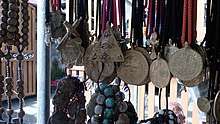Agimat
Agimat, also known as anting or anting-anting, is a Filipino word for "amulet" or "charm".[1] Anting-anting is also a Filipino system of magic and sorcery with special use of the above-mentioned talismans, amulets, and charms. Other general terms for agimat include bertud and galing.[2]
 |
|
Mythical beings
|
|
Mythical heroes
|
| Agimat |
|---|
| Dambana |
| Philippine mythological figures |
| Philippine mythological creatures |
| Religion in pre-colonial Philippines |
| Anito |
| Philippine shamans |
| Kulam |
| Indigenous Philippine religions |
| Tagbanwa religion |
| Tagalog religion |
|
|


It is part of a wider Southeast Asian tradition of tribal jewelry, as "gantung" (meaning "hanging") in Indonesian/Malay and "anting-anting" (meaning "ear pendant") in Javanese.
Description
In the Philippine occult tradition, there is usually a corresponding agimat to deal with in a particular area in a person's life. The most frequent types of agimat are used for removing hexes and exorcism of evil spirits. An agimat also called a gayuma serves as a love charm which makes the owner more attractive to the opposite sex.[3] Although stereotyped as a cross, a flat, round or triangular golden pendant accompanying a necklace or a necklace-like item, it is also depicted as an enchanted stone that came from the sky or a fang left by a lightning strike (pangil ng kidlat) or even a drop of liquid from the heart of a banana tree at midnight (mutya). In relation to the latter, it is usually ingested. An agimat is usually accompanied by a small book of magic incantations which must be read during Good Friday or a certain special date to attain the amulet's full power and benefit. An agimat could also be in the form of a clothing with magic words inscribed on it, or even in the form of edible enchanted mud (putik in Tagalog).[4]

Other methods of obtaining an agimat is by getting the liquid that is drained from an exhumed body of an unbaptized child or aborted fetus or offering food and drinks to the spirits in a cemetery during midnight of Holy Wednesday or Holy Thursday.[5] Most of the amulets bear Latin inscriptions into it. Like those in Quiapo district in Manila, most of the agimat merchants are near churches (like in its courtyard or in the marketplace just nearby). Filipino freedom fighters also wore anting-anting to battle against the Spaniards and the Americans. Filipino hero Macario Sakay wore a vest that has religious images and Latin phrases to protect him from bullets.[6] Former Philippine-President Ferdinand Marcos, was given an anting-anting by Gregorio Aglipay that could supposedly make Marcos invisible.[7] Marcos said that the agimat is a sliver of wood that was inserted into his back before the Bataan campaign on 1942.[8]
Earliest reports of anting-anting are from the records of Spanish priests in the early colonial period. Pardo de Tavera defines the anting-anting as "an amulet, of super natural power, that saves lives." With the Christianization of the Philippines, anting-anting appropriated the forms of the new religion, and incorporated as well the esoteric symbolisms of Freemasonry. An Islamic version of anting-anting exists in the Southern Muslim islands.[4] In Filipino films, the wearer of the agimat gains superhuman strength, invisibility, heightened senses, self-healing, and elemental powers. With it, the person can also be able to shoot or fire lightning via hands, or generate electricity throughout one's body. The person can also perform telekinesis, stop a live bullet, can have premonitions, invisibility, flight, morphing abilities, camouflage abilities like a chameleon, can have extreme good luck, possess invincibility, or perform miracle curative powers. In his Filipino films, actor Ramon Revilla, Sr., as Nardong Putik, was depicted to have protection from bullets and slash wounds, provided he eats a certain special mud.[9]
Subtypes
Agimat maybe further classified into different types based on their purported sorcerous powers, they include:[2]
- Kabal (or kunat) - agimat that supposedly make the skin invulnerable to cuts and sword slashes.
- Pamako - agimat that supposedly paralyze an opponent
- Tagabulag - agimat that supposedly turns the wearer invisible
- Tagaliwas - agimat that can supposedly deflect bullets.
See also
References
- "Tagalog-English Dictionary by Leo James English, Congregation of the Most Holy Redeemer, Manila, distributed by National Book Store, 1583 pages, ISBN 971-91055-0-X
- Stuart, Godofredo U. "The anting-anting, the Philippine amulet, is an essential part of the Filipino folk credo and mythological makeup". StuartXChange. Retrieved 26 August 2019.
- "The Agimat and the Anting-Anting: Amulet and Talisman of the Philippinesn". Archived from the original on 2016-09-24. Retrieved 2012-08-19.
- Galang, Reynaldo S. "Anting anting, the Filipino Warrior's Amulet" Archived July 30, 2008, at the Wayback Machine, Bakbakan International, Bakbakan.com (1994, 1997)
- Ileto, Reynaldo Clemeña (1997). Pasyon and revolution. Ateneo de Manila University Press. pp. 22–23. ISBN 978-971-550-232-0. Retrieved 2009-05-13.
- Flores, Paul (1996). "Reading 1 - Macario Sakay: Tulisán or Patriot?". The University of Auckland. Archived from the original on July 11, 2004. Retrieved 2008-07-24.
- Karnow, Stanley. In Our Image: America’s Empire in the Philippines, Ballantine Books, Random House, Inc., March 3, 1990, 536 pages, ISBN 0-345-32816-7
- Steinberg, David Joel (2000). The Philippines: a singular and a plural place. Basic Books. p. 89. ISBN 978-0-8133-3755-5. Retrieved 2009-05-13.
- IMDB Information: Nardong Putik